#explain Topology
Explore tagged Tumblr posts
Note
Can you explain why four dimensions is so special? I’ve heard that, in very broad strokes, for n < 4 the ways things can “fit together” are relatively limited, while for n > 4 there’s enough space to freely move things around and cut chunks out, and somehow at n = 4 these forces of restriction and freedom balance out. But I’d love to get a more detailed description. Does it really all just come down to surgery only working for n > 4?
The broad strokes are basically right. But if you want a more detailed answer, I think we can go slightly more simple than surgery.
Suppose we have an ambient n-manfold M, and two submanifolds A, B which intersect transversely in two points, with opposite orientation. Formally, pick an arc in A and an arc in B between the two points. Assign local orientation to one point, transport this orientation along each arc. These orientations should disagree by the time we reach the other intersection point.
We would ideally like to resolve these intersections, kinda like this. This is called the Whitney trick.
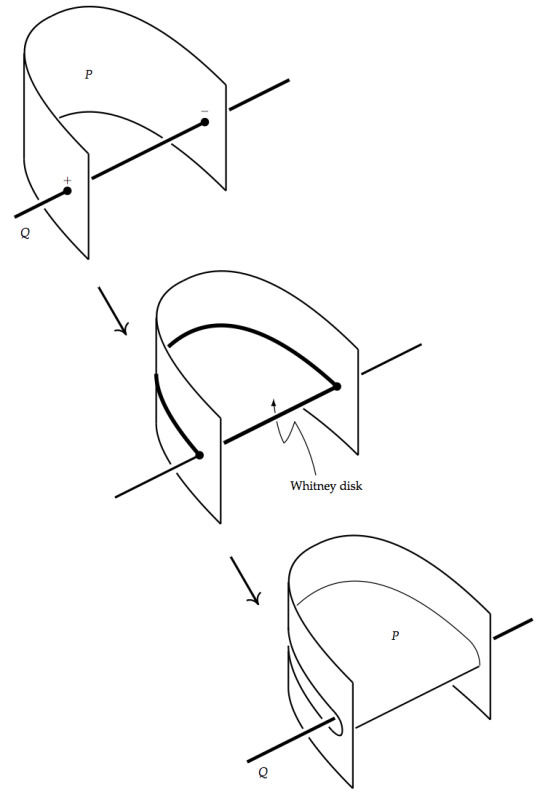
Again, more formally, what this involves is finding a disc bounded by those two arcs (whose interior is disjoint from A and B), and "pushing A off of B along the disc". Details aren't hard, but the picture is more helpful.
It turns out that (so long as the loop formed by the union of the arcs is nullhomotopic in M), this is always possible if n≥5. If n=4, it's sometimes possible, but sometimes not. But whereas it's "generally not possible" in the smooth setting, it is "generally possible" topologically.
This intersection resolving is how you prove the h-cobordism theorem, and hence high-dimensional Poincaré, etc. When trying to do surgery, Freedman showed that the arising situations are ones that work topologically but not smoothly (for a large class of fundamental groups at least). So the topological surgery sequence is exact, while the smooth one isn't.
In lower dimensions, this completely doesn't work, but in exchange DIFF and TOP are equivalent categories so it doesn't matter at all.
55 notes
·
View notes
Text
How to play nDimensional Time Travel chess:
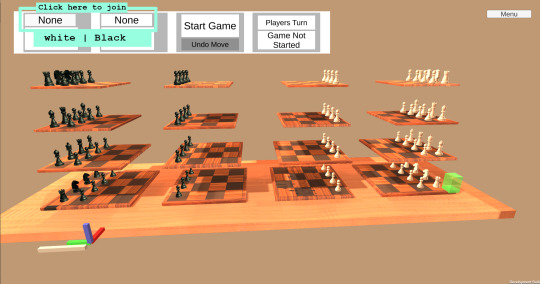


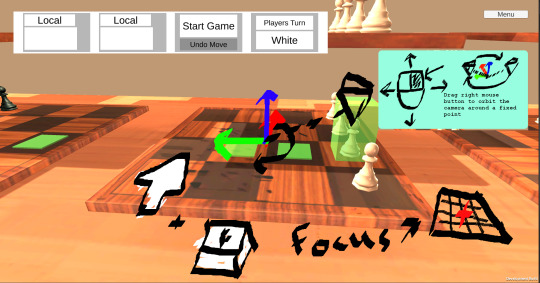
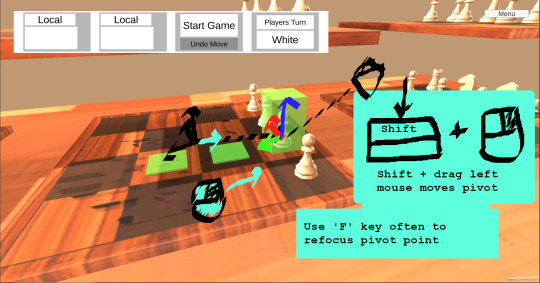
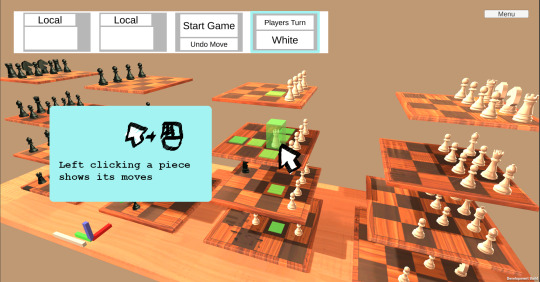
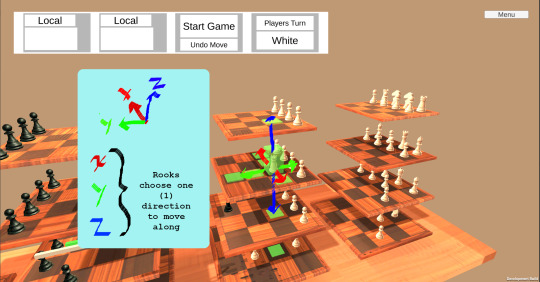
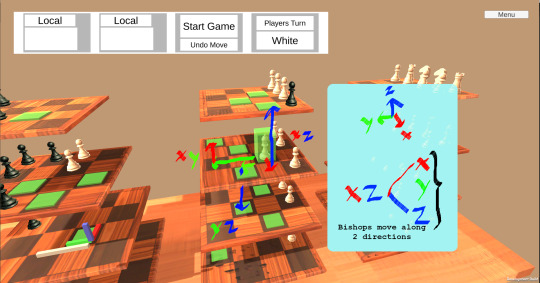
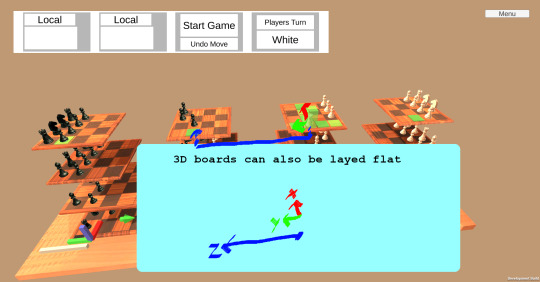
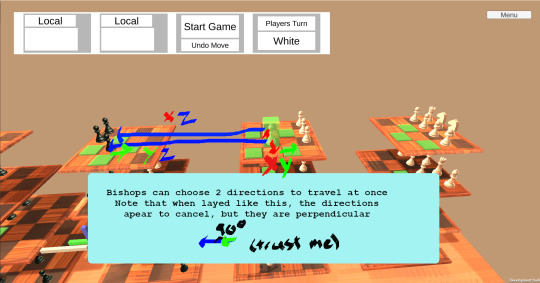
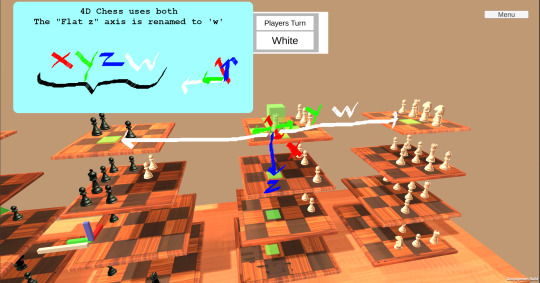
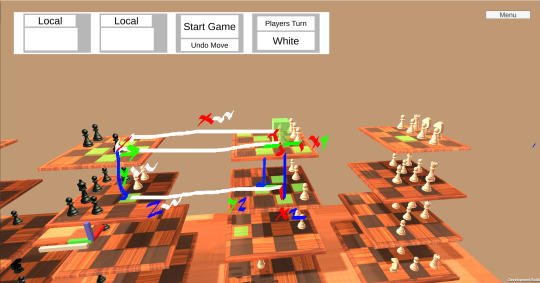
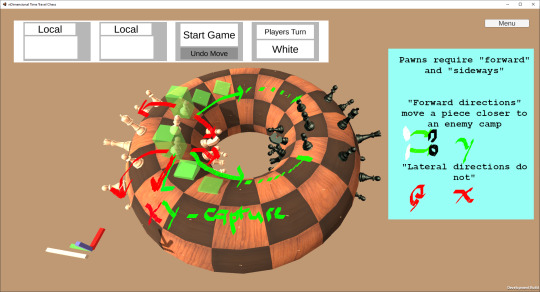
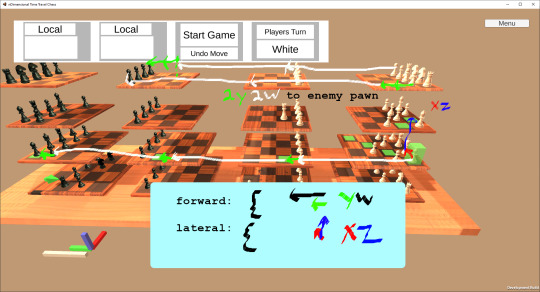
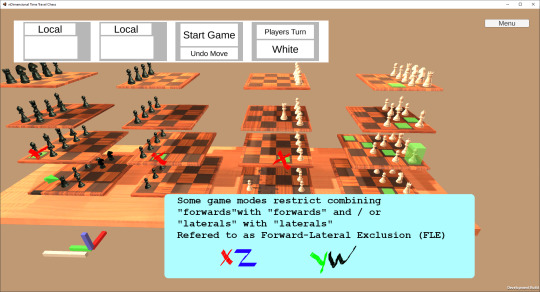
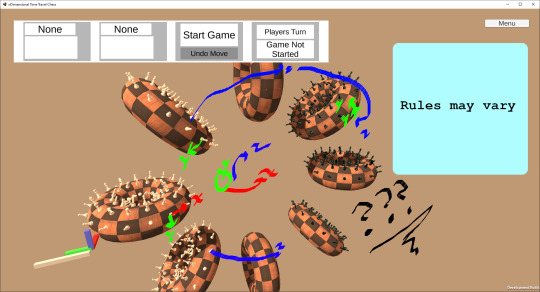
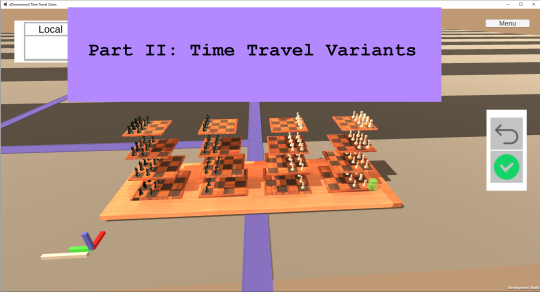

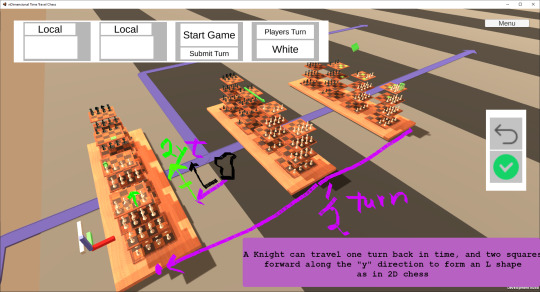
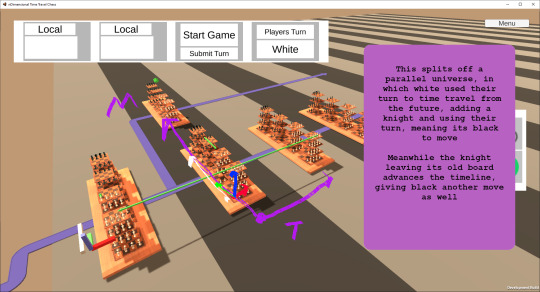
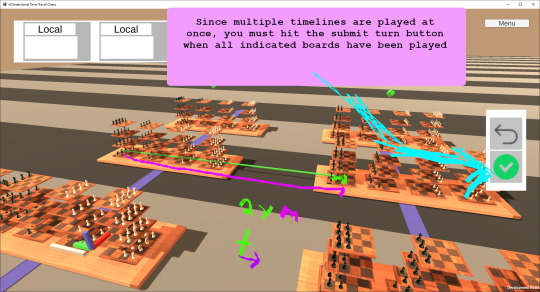
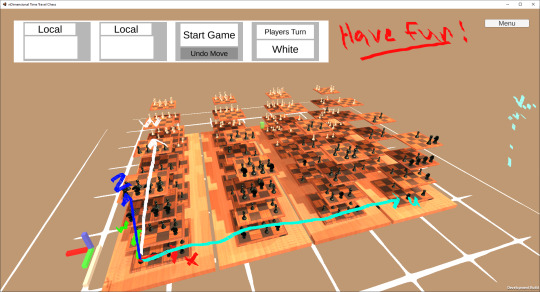
#chess#chessboard#5d chess with multiverse time travel#5D chess#torus chess#torus#mathblr#codeblr#progblr#topology#tesseract#time travel#fairy chess#game dev#unity3D#dount#donut#tutorial#how to#this should explain everything
161 notes
·
View notes
Text
spending my afternoon engrossed in the study of applied topology (untangling the ball of yarn I'm using to knit a blanket)
2 notes
·
View notes
Text
New favourite way to bamboozle undergrads: tell them Spec(Z) is just like the 3-sphere.
#there's some good reasons for why this analogy works#besides theorems carrying over#it's actually pretty cool#might explain them in a future post#math#mathblr#arithmetic topology
39 notes
·
View notes
Text
My beautiful topological horror
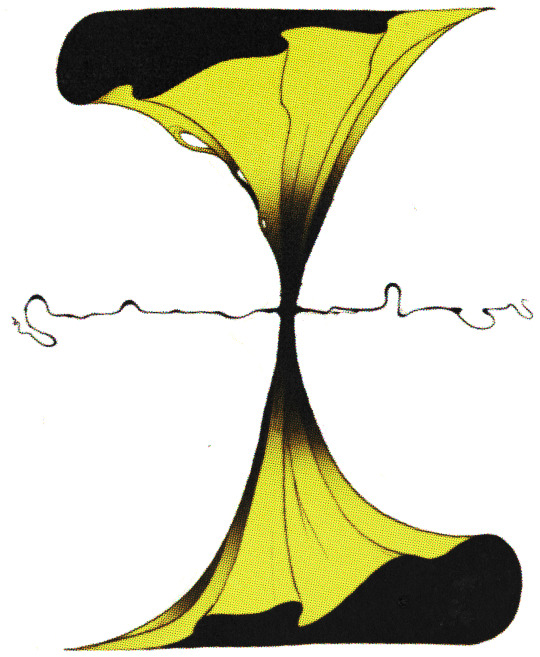

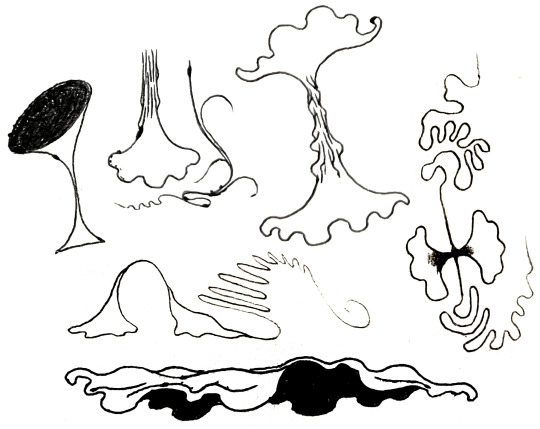
The fractured king
#eldritch beings are just weird topology propoganda#I love this so much#I can't draw but this is how I always wanted to see eldritch beings represented#like a 2d character seeing a 3d hand as like frames I can't explain it but imagine 4d beings! WE CAN'T!#yay#john malevolent
1K notes
·
View notes
Text
You might be tempted to get nitpicky and call IKEA a "labyrinth" , as there's only one path so you can't get lost. With no branches and no dead ends, surely this is a labyrinth, right?

Nope! While IKEA's design resembles a labyrinth, it's only actually one if you ignore the included "shortcuts". Since there's nothing stopping you from taking a shortcut backwards to an early section of the maze, you can indeed get stuck in an infinite loop and never make it to the end. You can get lost in an IKEA, making it a maze and not a labyrinth.
I'd draw some topological diagrams to explain this but I'm on mobile. Maybe later, if this is too confusing.
1K notes
·
View notes
Text
why do people think algebraic topology deals with ALL topological spaces. like. genuinely. why do people who have taken an introductory course in algtop think we deal with ALL topological spaces. explain to me how the fundamental group, the notion of homotopy of continuous maps, or singular homology are supposed to deal with all the monstrosities allowed by point-set topology. yes we restrict ourselves to more reasonable spaces. of course we do. why do people not know this
79 notes
·
View notes
Text
An international team led by Rutgers University-New Brunswick researchers has merged two lab-synthesized materials into a synthetic quantum structure once thought impossible to exist and produced an exotic structure expected to provide insights that could lead to new materials at the core of quantum computing. The work, described in a cover story in the journal Nano Letters, explains how four years of continuous experimentation led to a novel method to design and build a unique, tiny sandwich composed of distinct atomic layers. One slice of the microscopic structure is made of dysprosium titanate, an inorganic compound used in nuclear reactors to trap radioactive materials and contain elusive magnetic monopole particles, while the other is composed of pyrochlore iridate, a new magnetic semimetal mainly used in today's experimental research due to its distinctive electronic, topological and magnetic properties.
Continue Reading.
83 notes
·
View notes
Text
Damn the Torpedoes (Stucky kidfic AU)
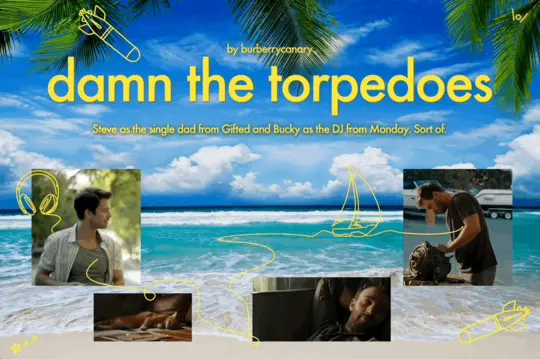
Summary: That spring Steve hears a lot about what’s big in algebraic topology from Mary as she talks a mile a minute in the car passenger seat, across the dinner table, under worn-out beach umbrellas or climbing up him like he’s still her favorite jungle gym though she’s almost too big now. What he gathers mostly is that, in order to classify shapes, mathematicians spend a lot of time trying to distinguish between differences that matter and those that don’t.
And isn’t that the trick in life, thinks Steve: figuring out what matters.
(Doesn’t help in explaining Bucky, though, but he’s not sure what would.)
—
Or: Steve as the single dad from Gifted and Bucky as the DJ from Monday. Sort of.
Read Chapter 1 on AO3
Many thanks to my betas @village-skeptic, @booksandabeer, @beautifuldiscojolras, @norelationtoatticus and @atomicstaci 🥰
#stucky#stucky fanfiction#stucky fic#stucky kidfic#stucky au#steve x bucky#stevebucky#stevebucky fic#steve rogers x bucky barnes#steve and bucky#bucky barnes#steve rogers#otp: till the end of the line#damn the torpedoes#tampa!verse#otp: even when i had nothing i had you#the existential loneliness of steven g. rogers#bucky barnes needs a hug#steve rogers also needs a hug#dad steve does it for me way more than I would have thought#self-knowledge for better or worse#not on my 2025 fic writing bingo card but here we are#we all deserve a feel-good story#or as feel-good as the world allows#the tragicomic nature of being a person
52 notes
·
View notes
Text
Fuuckk I just had the alternative reality cinema blast in my dream again, it was sooo good and I'm again lamenting something isn't a real movie.
Just now, I dreamed of a surreal slice of life objectum double-romance drama called "Ornate", it looked like something from the 90s.
It features two human protagonists and is a story about their ordeals in the love prosuit of two abstract beings. I can't really explain the experience, but the film is set in the world where humans live alongside (or at least interfaces regularly with) these abstract extradimentional beinds that all work in some kind of shared environment. they all have "office positions," but whatever they're working with is far beyond human comprehension. The highlight of this entire feast of surreal storytelling is by far the visuals. The film reeks of 90 and reeeally us-american, but in this very sentimental way, the thing feels very touching. The settings and designs are both super representative yet disjointed in a fascinating manner, somewhat remenicent of "The good Place's" approach to humor and representation of the unfathomable. Has a touch of that old-fashioned liminal surrealism, too. There's no sci-fi elements, just very ostentatious, but regular interior designs. Nevertheless, "Demolition man" comest to mind as a mood reference for its cinematography. If I vere more versed in 90s movies, I'd probably list some more actually descriptive references.
The story is a bit hard to puzzle with me forgetting it as I type, and even in a dream, the framing device is of me watching a movie in parts, interrupted by other things.
There's a total of 6 characters I remember. 2 humans: a blonde buisness lady (looks like a mix of Skyler White and the agent from X files) and a brunette office guy (looks a lot like a dark haired guy from pulp fiction, the one from "confused" meme). They're definitely friends, maybe coworkers even. Enter: blonde's love interest, a collapsible grid I remember the most about story vice. She's a well-respected asset in her agency and is on good personal term with the "boss". However, a bit uptight and very stern, which her superior is really set on correcting. In her introductory scene, she seems to be in a role of something like a rehabilitation social worker to some other abstract being, that seemed to have misbehaved in some manner in the past, and is a bit mentally troubled. The Grid is shown to be mean to her, disregarding the assignment. However, over the course of the encounter, the other being managed to get under her skin in a way that softens the dynamic. I do wish I remembered the contence of the dialog, but these details may actually be nonsensical outside of dream logic conscious state. It is later revealed Grid's boss paired the two on purpose in hopes of improving her demeanor. Though it's hard to parce but from the general vibe, these creatures are meant to be some kind of spiritual guides and an incarnation of cosmic restorative justice. There's definitely something angelic at play, tho I think the inherent vaguness of their station is part of the point.
A note about abstract beings' designs: Grid is the only one I remember forms of well. Most of the time, she was this geometric constuct on 2 support, the entire shape sonsisting of a grid. The tips of the supports that touched the ground were 2 yellow balls. At some point, she was stressed and collaped in on herself, intersecting her own boundaries like a topological ghost, hence the collapsible part. At some other point in the plot, she was also represented as a bath-room in turquoise. The other design I remember is of that being she was "assisting" in the introductory scene. she looked like a floating series of flat, oblong slices in plum. I think I may be able to sketch these sometime, and I think these examples may give you an idea of a general design philosophy of these abstract beings.
As Blonde's love interst, Grid semed like quite the undertaking to court her, but they seemed to have managed.
The guy's storyline with his abstract partner, I remember way worse. I think they might've been a thing already by the start of the plot, and the abstract companion in this case was way more layed back. I recall the guy giving blondie advice about her situationship with Grid, who seem to be way more of a challenge.
The cruks of the story are somewhat esoteric, but ultimately wholesome? There was a conflict, and the resolution somehow involved the cast (humans and their abstract lovers) standing up to the Boss to communicate discontent with its expectations of moral perfectionism on the part of it'sunderlings? Something of that viraity. The boss was actually quite a prominent presence and even aided the lovers' quest, but seems to have a blind spot in its expectations of its underlings, as too pure and uncapable of malice, which ironically denied them the same agency humans get. The conclusion (?) is just kinda about the strangely mondane stuggle of yearning and prosuit of incomprehensible, how truly clise with are with it, and the boundless abandon of human love. I hope my descriptions did the experience justice enough to get the feeling across. Oh well.
44 notes
·
View notes
Text
Explanation Posts
I explain my url (continuity in ℝ) 05/06/2022
Definition of a Ring 07/10/2022
Definition of a Metric Space 16/10/2022
Open and Closes sets in a Metric Space 16/10/2022
Convergence and Continuity in Metric Spaces 22/10/2022
Bounded and Compact sets in a Metric Space 23/10/2022
I show 0.9999...=1 30/11/2022
Linear Maps and Isomorphisms 18/01/2023
Ring homomorphisms, Ideals, Quotients, and the First Isomorphism Theorem 12/03/2023
Mutamorphic Functions (technically not an explanation post but still belongs here) 29/06/2023
Second Countability of ℝⁿ 04/07/2023
The Weierstrass Function 23/08/2023
Unbroken Workbrooks (A post about continuity written in Anglish) 19/09/2023
Countable Sets have 0 Lebesgue Outer Measure 17/10/2023
Introduction to Homotopy 05/02/2024
The Fundamental Group 16/02/2024
Continuity in Terms of Open Sets 16/02/2024
The Set of Finitely Generated Free Groups as a Monoid 01/03/2024
Intro to Topology: Metric Spaces 12/03/2024
Intro to Topology: Topological Spaces and Continuity 19/03/2024
Intro to Topology: Closed Sets and Limit Points 26/03/2024
Intro to Topology: Hausdorffness 26/03/2024
Intro to Topology: Connectedness 27/03/2024
Intro to Topology: Path Connectedness 28/03/2024
Intro to Topology: Compactness 11/04/2024
Intro to Topology: Bases and Second Countability 12/04/2024
Intro to Topology: Product Spaces 23/04/2024
Intro to Topology: The Heine-Borel Theorem 24/04/2024
Intro to Topology: Quotient Spaces 25/04/2024
Intro to Topology: Important Examples 26/04/2024
Intro to Topology: Conclusions and Remaining Questions 26/04/2024
The Dirac Delta Distribution is not an Extended Real Function 03/05/2024
The Fundamental Group of a Topological Group is Abelian 10/06/2024
Proof of the Factor Theorem 30/06/2024
A Short Intro to Category Theory 23/10/2024
An Example of When Connectedness Implies Path Connectedness 17/11/2024
Relative de Rham Cohomology 13/06/2025
204 notes
·
View notes
Text
Geometric topology proofs are either "we draw a commutative diagram and the result follows immediately from well-known homotopy theory [Whi78] :)" or the most ill-explained, possibly untrue diagram manipulations and terrifying handle constructions you've ever seen. And sometimes both.
#ive been stuck on the same point for weeks#i was hoping the proof would of the former type#i fear not#cognisance#math posting#topology
21 notes
·
View notes
Text
After 4 years of work, I've finally published my very first peer-reviewed theory paper: Design rules for controlling active topological defects
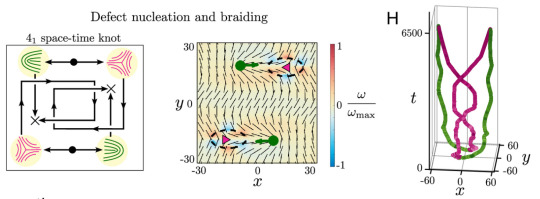
(and it's open access! :D)
I am sooo excited to finally be able to share this! I'll probably write some more in the future about what it was like to work on this project, but for now here's what I want to say about it:
I think this work is a beautiful example of how the long, meandering paths of curiosity-driven research can bring us in completely unexpected directions, yielding new ideas and technologies that might never have been found by problem- or profit-driven research.
We started this project because we were interested in the fundamental physics of active topological defects; we wanted to understand and develop a theory to explain their effective properties, interactions, and collective behaviors when they're hosted by a material whose activity is not constant throughout space and time.
Along the way, we accidentally stumbled into a completely new technique for controlling the flow of active 2D nematic fluids, by using symmetry principles to design activity patterns that can induce self-propulsion or rotation of defect cores. This ended up being such a big deal that we made it the focus of the paper, for a few reasons:
Topological defects represent a natural way to have discrete information in a continuous medium, so if we wanted to make a soft material capable of doing logical operations like a computer, controlling active defects might be a really good way of putting that together.
There have also been a number of biological systems that have been shown to have the symmetries of active nematics, with experiments showing that topological defects might play important roles in biological processes, like morphogenesis or cell extrusion in epithelia. If we could control these defects, we'd have unprecedented control over the biological processes themselves.
Right now the technique has only been demonstrated in simulations, but there are a number of experimental groups who are working on the kinds of materials that we might be able to try this in, so hopefully I'll get to see experimental verification someday soon!
#physics#soft matter#materials science#science#academia#mathematics#topology#biology#biotechnology#tech#publishing#196
79 notes
·
View notes
Text
Dungeon Meshi Adventurer's Bible World Part 3
Gnomes, Ogres, Orcs, Kobolds, and Beast-men
Gnomes
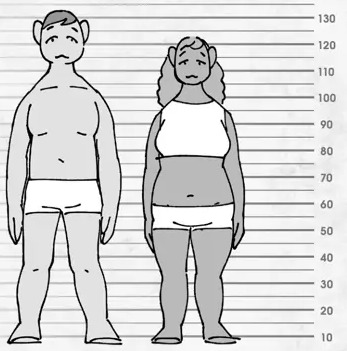
My personal headcanon is gnomes are the closest to the original humans before they split into the various subcategories from the demon's magic.
Gnome settlements are roughly alongside dwarf settlements but they don't really overlap. The map denotes "areas with the largest populations" so it might mean "areas where this race is the most common" rather than "This area is heavily populated by this race."
I wouldn't expect gnomes and dwarfs to get along considering the general stereotype they might usually have. But I suppose they have no reason to have beef with each other because the dwarfs don't engage in any practices related to spirits that would anger the gnomes. Like, gnomes are friendlier to atheists than they are to heretics.
Alternatively, the gnomes and dwarfs get along because they both hate elves more. Just look at that dwarf who was all "I hate those elves too" when the gnomes and elves started arguing in the comic.

We know gnomes and dwarfs can have viable chidren with each other and Tall-men can have viable children with ogres and half-foots, so maybe lifespan is the big determining factor for viable cross-breeds. There were no notes about elves so they may be unable to have viable cross-breed children with anyone since they're long-lived for even long-lived races.
The gnome comic ends on such a grim but appropriate note. Ultimately, the spirits don't care how they're used. They will do what they're told and they will perform as strictly or as loosely as you let them. The fighting between the gnomes and elves over the proper use of spirits is pointless because the spirits favor neither method and will kill both of them if told to.
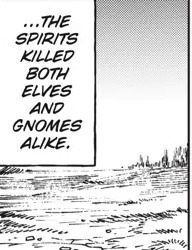
Ogres

I've said a few times that Dungeon Meshi's world-building style is deep rather than wide. Ogres are a great example of that. They exist, but nobody pays any mind to them. Everyone acknowledges them as a thing and no one really thinks there's anything unusual about them. The story doesn't care to explain anything about them because nothing we could learn about them is necessary to telling the story.
Ogres exist in small pockets of the Eastern Archipelago and a small area in the north-east part of the Western Continent, but they once had a large nation of their own but there's no mention of where that is. And there's speculation that their population decline could be for a number of reasons such as not being able to ride horses to suffering frequent food shortages.
Considering where they're located, the ogres have probably been in decline because of the destruction caused by the ancient war. If we assume the Western Continent was formerly bountiful enough to sustain a large ogre population, the sudden devastation from the ancient war would cause the population to die down.
Tall-men and ogres probably both relocated to the Eastern Archipelago after the war and were able to force the long-lived races to leave them be. But the archipelago likely has the same general issue for ogres that it's not able to sustain a large population of them.
Tall-men in the Eastern Archipelago seem to have a sort of inverse perception of having ogres in their court that other Tall-men have about having elves in their court. They're both status symbols but ogres are a sign of strength rather than wisdom.
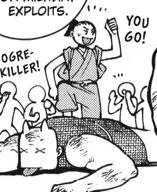
Orcs
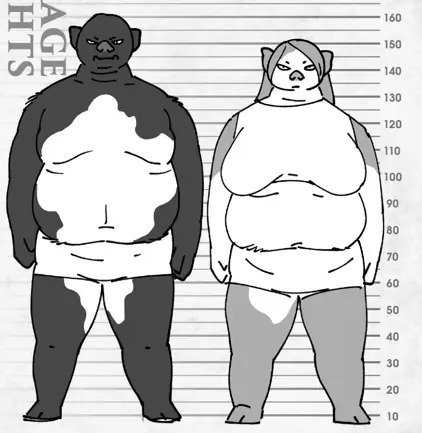
On the surface, orcs live in small mountain settlements in the Eastern, Southern, and Western Continents. The world map doesn't include any topological information but we do know Kahka Brud is a mountainous area from the chapter 48 title image. I suppose the central and eastern parts of the Eastern Continent, the lower central part of the Southern Continent and the North-east area of the Western Continent are mountainous. The orc settlement in the Western Continent is also adjacent to the Ogre settlement there.
When Zon talked about the history of orcs, he showed a lot of hatred for elves and general dislike for Tall-men, but didn't seem to have anything against dwarfs, though that might be because Senshi was a friend.
This is setup to argue that I think the orcs lived primarily in the Western Continent prior to the ancient war. But when the elves and dwarfs fought each other, the orcs were forced out of their land and then the Tall-men that settled after continued to drive the orcs away.
Orcs don't actually have natural horns. They implant bits of monster bone under their skin to look like horns. And social rank determines how prominent they're allowed to make the bumps. Zon and the other male orcs in his group had prominent horns on their heads. The one's in Leed's group either had nothing at all or just mild bumps.
The horn details could just be Kui explaining away changes to orc appearances she made during the series. The first time they appeared, they had human feet but they later had pig feet for example. Even still, it would imply the highest rank (and probably strongest) orcs were the ones who evacuated the women and children when the red dragon appeared on the fifth floor. Since rank also determines the number of spouses they can have, it could also just be the orcs with families stayed together while the orcs with no one they need to worry about stayed behind.
The orc clan in the dungeon might be a general outlier to how orcs typically interact with outsiders. The island dungeon had been left undiscovered for 1,000 years and the kingdom residents trapped inside gave them their crops. Even the ghosts on the fifth floor were fairly benign. Gillan's group was probably the closest thing the orc tribe had to hostiles in generations. So when they met Senshi, they were willing to treat him as a guest as long as he respected their customs.
They were even willing to adopt non-orcs into their tribe. With how long Senshi lives compared to them, he could have become a dwarf chief of the orcs if he'd wanted to.
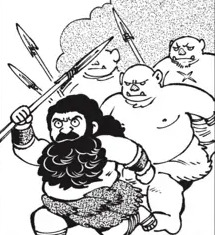
Kobolds
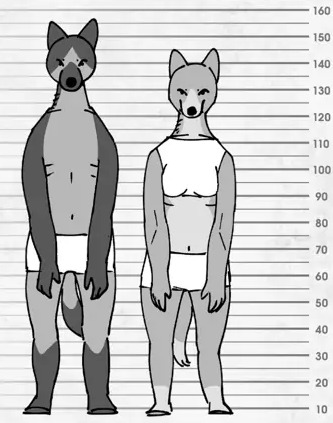
Their bio says there are slave merchants who specialize in selling kobolds and other demihumans. Kuro's backstory says he was caught while loitering at a port so the Western Continent ports probably have several slavers around them. I can imagine there are plenty of stories like Kuro's of Kobolds either wanting to or being encouraged to leave their home town to see the wider world only to end up a slave.
All the major kobold settlements are in the central and south parts of the Western Continent. Those places are probably some of the harshest environments in the world considering kobolds are highly poison resistant. The land probably has some of the most toxic animals in the world, and the soil and water may also contain toxic substances as well.
As Kabru explains it, all the good and bountiful land has been seized by the long-lived races, leaving the short-lived races and demihumans to fight for whatever's left.
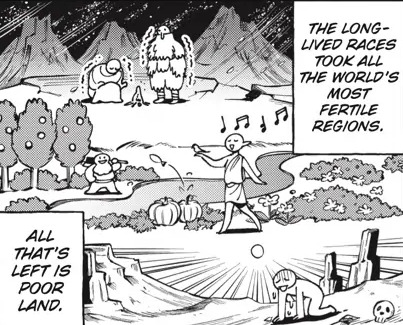
Kabru said kobolds as a rule are cruel, aggressive, and you can't hope to communicate with them. Then he was shocked that Laios and Falin feel the exact same way about a Tall-man mountain tribe that lives near their village.
Kabru almost connected the dots there. Everything he said about kobolds is dehumanizing propaganda and stereotypes to justify killing them just like the what Laios's village says about the mountain people to kill them. If they could discard those prejudices, all the peoples of the world would realized they are more alike than they are different. Despite their vast physical differences in body shape, ability, and lifespan; there is something they can all agree on that is far greater than any of these things that divide them. What they can all agree on is the aristocratic elves all suck by the way.
Beast-men

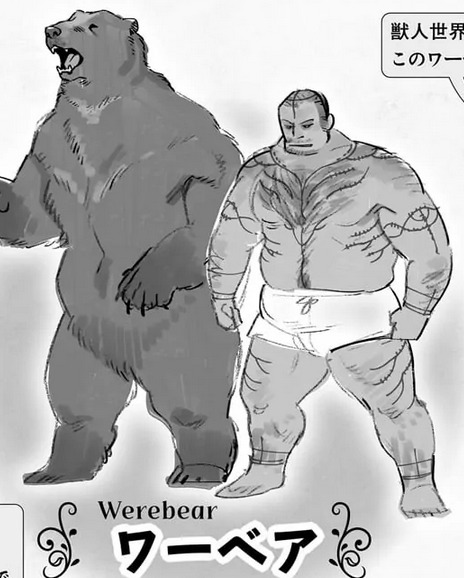
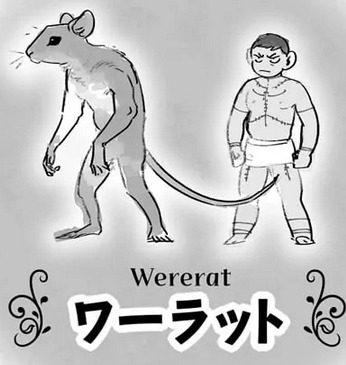
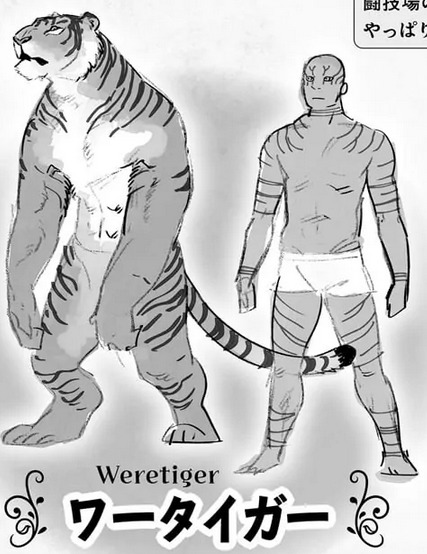
This section was added in the Complete Edition. Lycion comments on the various beast-man forms that exist. I don't have a direct translation of these pages, but I did find a translation of Kui's blog about the werewolf, werebear, and wererat.
Lycion's comments on werewolves is they are the most common beastmen in the arena since they have loose requirements and don't cause much physical strain or personality change. He also thinks that werewolf fights would be more interesting if a pack of them fought a bigger enemy. They also tend to hang around with each other in their human forms.
Werebears are the strongest beastmen but require a huge body frame to use them. And the physical toll on their body is so intense that they don't have long fighting careers.
Wererats are typically Half-foots because they're one of the few animals that a Half-foot can meet the physical requirements for. They're not very strong so they're used more entertainment, probably akin to a rodeo clown.
I don't have a translation for the weretiger, but from the images I think it's safe to assume they tend to be loners even when they're in their human form and they don't get along well with werewolves.
The pattern of the runes on the beast-men's bodies are all completely different depending on what kind of beast-man you are.
And then there's a comic where Lycion reveals to Izutsumi that she's actually a werehuman. She's a cat with a human soul implanted into her. I guess this would make her a man-beast.
Lycion said there isn't a way to suppress Izutsumi's soul hence why she stays in her hybrid form all the time. His commentary on werewolves said they don't cause much of a personality change, so that might factor heavily in their ability to suppress their second soul. Since Izutsumi's human soul dominates her personality to the point that she thinks it's the original soul, she can't suppress it even if she wanted to.
Romance
There's one last comic about the different opinions of the short- and long-lived races on romantic relations with each other. I don't have a translation but I think I got the gist of it by just the images.
Basically, short-lived races tend to find having a long-lived partner romantic and desirable, but the long-lived races tend to be more uncomfortable with the idea.
There's also a lot of negative assumptions heaped upon long-lived people who date short-lived people. Among them is the notion that they actually treat their short-lived partners like pets or children.
But no matter how hard they try to stop them, people will always love who they love.
back
19 notes
·
View notes
Text

Scientists merge two 'impossible' materials into new artificial structure
An international team led by Rutgers University-New Brunswick researchers has merged two lab-synthesized materials into a synthetic quantum structure once thought impossible to exist and produced an exotic structure expected to provide insights that could lead to new materials at the core of quantum computing. The work, described in a cover story in the journal Nano Letters, explains how four years of continuous experimentation led to a novel method to design and build a unique, tiny sandwich composed of distinct atomic layers. One slice of the microscopic structure is made of dysprosium titanate, an inorganic compound used in nuclear reactors to trap radioactive materials and contain elusive magnetic monopole particles, while the other is composed of pyrochlore iridate, a new magnetic semimetal mainly used in today's experimental research due to its distinctive electronic, topological and magnetic properties.
Read more.
#Materials Science#Science#Quantum mechanics#Quantum computing#Dysprosium#Titanium#Iridium#Materials synthesis#2D Materials#Spintronics#Semimetals#Fermions#Rutgers University
14 notes
·
View notes
Text
Interesting Papers for Week 20, 2025
How Do Computational Models in the Cognitive and Brain Sciences Explain? Brun, C., Konsman, J. P., & Polger, T. (2025). European Journal of Neuroscience, 61(2).
Sleep microstructure organizes memory replay. Chang, H., Tang, W., Wulf, A. M., Nyasulu, T., Wolf, M. E., Fernandez-Ruiz, A., & Oliva, A. (2025). Nature, 637(8048), 1161–1169.
Dendrites endow artificial neural networks with accurate, robust and parameter-efficient learning. Chavlis, S., & Poirazi, P. (2025). Nature Communications, 16, 943.
Modelling sensory attenuation as Bayesian causal inference across two datasets. Eckert, A.-L., Fuehrer, E., Schmitter, C., Straube, B., Fiehler, K., & Endres, D. (2025). PLOS ONE, 20(1), e0317924.
Synaptic basis of feature selectivity in hippocampal neurons. Gonzalez, K. C., Negrean, A., Liao, Z., Terada, S., Zhang, G., Lee, S., Ócsai, K., Rózsa, B. J., Lin, M. Z., Polleux, F., & Losonczy, A. (2025). Nature, 637(8048), 1152–1160.
Fast updating feedback from piriform cortex to the olfactory bulb relays multimodal identity and reward contingency signals during rule-reversal. Hernandez, D. E., Ciuparu, A., Garcia da Silva, P., Velasquez, C. M., Rebouillat, B., Gross, M. D., Davis, M. B., Chae, H., Muresan, R. C., & Albeanu, D. F. (2025). Nature Communications, 16, 937.
Theory of morphodynamic information processing: Linking sensing to behaviour. Juusola, M., Takalo, J., Kemppainen, J., Haghighi, K. R., Scales, B., McManus, J., Bridges, A., MaBouDi, H., & Chittka, L. (2025). Vision Research, 227, 108537.
Network structure influences the strength of learned neural representations. Kahn, A. E., Szymula, K., Loman, S., Haggerty, E. B., Nyema, N., Aguirre, G. K., & Bassett, D. S. (2025). Nature Communications, 16, 994.
Delayed Accumulation of Inhibitory Input Explains Gamma Frequency Variation with Changing Contrast in an Inhibition Stabilized Network. Krishnakumaran, R., Pavuluri, A., & Ray, S. (2025). Journal of Neuroscience, 45(5), e1279242024.
Predicting the Irrelevant: Neural Effects of Distractor Predictability Depend on Load. Lui, T. K., Obleser, J., & Wöstmann, M. (2025). European Journal of Neuroscience, 61(2).
The time course and organization of hippocampal replay. Mallory, C. S., Widloski, J., & Foster, D. J. (2025). Science, 387(6733), 541–548.
Anisotropy of the Orientation Selectivity in the Visual Cortex Area 18 of Cats Reared Under Normal and Altered Visual Experience. Merkulyeva, N., Lyakhovetskii, V., & Mikhalkin, А. (2025). European Journal of Neuroscience, 61(2).
The calcitron: A simple neuron model that implements many learning rules via the calcium control hypothesis. Moldwin, T., Azran, L. S., & Segev, I. (2025). PLOS Computational Biology, 21(1), e1012754.
High-Density Recording Reveals Sparse Clusters (But Not Columns) for Shape and Texture Encoding in Macaque V4. Namima, T., Kempkes, E., Zamarashkina, P., Owen, N., & Pasupathy, A. (2025). Journal of Neuroscience, 45(5), e1893232024.
Ventral hippocampus to nucleus accumbens shell circuit regulates approach decisions during motivational conflict. Patterson, D., Khan, N., Collins, E. A., Stewart, N. R., Sassaninejad, K., Yeates, D., Lee, A. C. H., & Ito, R. (2025). PLOS Biology, 23(1), e3002722.
Hippocampal coding of identity, sex, hierarchy, and affiliation in a social group of wild fruit bats. Ray, S., Yona, I., Elami, N., Palgi, S., Latimer, K. W., Jacobsen, B., Witter, M. P., Las, L., & Ulanovsky, N. (2025). Science, 387(6733).
Diverse neuronal activity patterns contribute to the control of distraction in the prefrontal and parietal cortex. Sapountzis, P., Antoniadou, A., & Gregoriou, G. G. (2025). PLOS Biology, 23(1), e3003008.
The role of oscillations in grid cells’ toroidal topology. Sarra, G. di, Jha, S., & Roudi, Y. (2025). PLOS Computational Biology, 21(1), e1012776.
Out of Sight, Out of Mind? Neuronal Gamma Oscillations During Occlusion Events in Infants. Slinning, R., Agyei, S. B., Kristoffersen, S. H., van der Weel, F. R. (Ruud), & van der Meer, A. L. H. (2025). Developmental Psychobiology, 67(1).
The Brain’s Sensitivity to Sensory Error Can Be Modulated by Altering Perceived Variability. Tang, D.-L., Parrell, B., Beach, S. D., & Niziolek, C. A. (2025). Journal of Neuroscience, 45(5), e0024242024.
#neuroscience#science#research#brain science#scientific publications#cognitive science#neurobiology#cognition#psychophysics#perception#neurons#neural computation#neural networks#computational neuroscience#neuroplasticity
8 notes
·
View notes